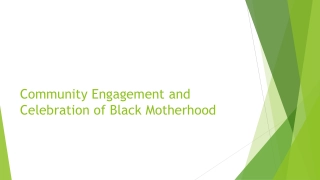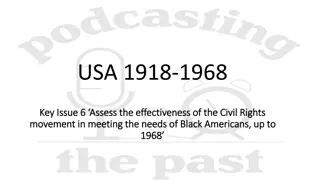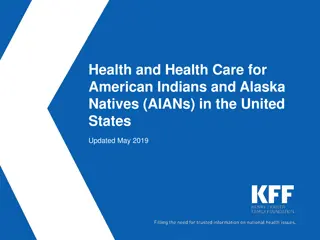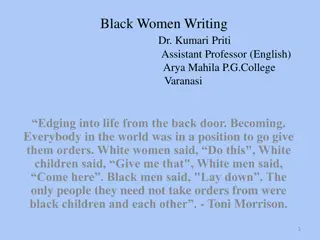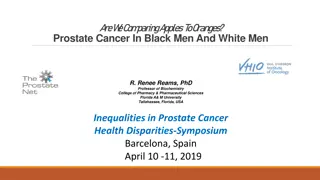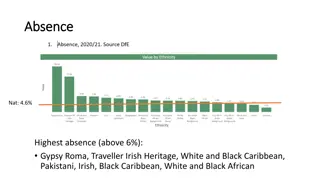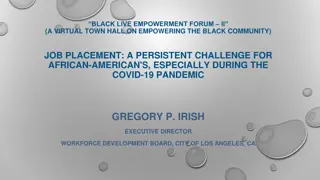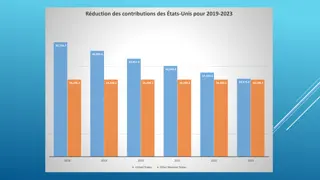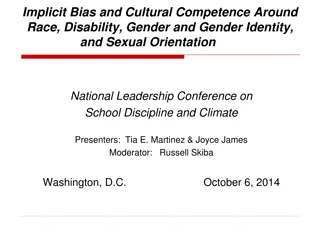Health and Health Care Disparities for Black Americans in the United States
Analysis of health and health care disparities for Black Americans in the US reveals significant challenges, including underrepresentation, economic disparities, and health outcome gaps. Despite improvements in some health measures, such as HIV diagnosis rates and teen birth rates, Black Americans still face inequities compared to their White counterparts. Social determinants like poverty, employment status, and geographic location further exacerbate these disparities. The data underscores the urgent need for targeted interventions to address these systemic issues.
Download Presentation

Please find below an Image/Link to download the presentation.
The content on the website is provided AS IS for your information and personal use only. It may not be sold, licensed, or shared on other websites without obtaining consent from the author. Download presentation by click this link. If you encounter any issues during the download, it is possible that the publisher has removed the file from their server.
E N D
Presentation Transcript
Health and Health Care for Blacks in the United States Updated May 2019
Figure 1 Blacks account for 12% of the population in the United States. 2017: 2060: Nearly 40 million people living in the U.S. are Black, making up almost 1 in 8 of the population. Blacks are projected to account for about 55 million people living in the U.S. by 2060. Note: Blacks are non-Hispanic. Source: Kaiser Family Foundation analysis of 2017 American Community Survey (ACS), 1-Year Estimates and U.S. Census Bureau 2017 National Population Projections Tables, https://www.census.gov/data/tables/2017/demo/popproj/2017-summary-tables.html.
Figure 2 Blacks make up a greater share of the population in the South, where most states have not expanded Medicaid. SHARE OF TOTAL POPULATION THAT IS BLACK BY STATE, 2017 <5% (19 States) 5%-15% (21 States) >15% (10 States + DC) 14 States with No Medicaid Expansion Note: Blacks are non-Hispanic and exclude individuals of mixed race. States outlined in black have not adopted Medicaid expansion as of May 2019. Source: Kaiser Family Foundation analysis of 2017 American Community Survey, 1-Year Estimates and Kaiser Family Foundation, Status of State Action on the Medicaid Expansion Decision, as of April 26, 2019, https://www.kff.org/health-reform/state-indicator/state-activity-around-expanding-medicaid-under-the- affordable-care-act/.
Figure3 Nonelderly Blacks are younger, more likely to be poor, and less likely to have a full-time worker in the family compared to Whites. Black White 84% 73% 57% 49% 21% 8% 34 and Younger Family Income Below Poverty Full-Time Worker in Family Note: Blacks and Whites are non-Hispanic and exclude individuals of mixed race. Includes nonelderly individuals 0-64 years of age. All values have a statistically significant difference from the White population at the p<0.05 level. Source: Kaiser Family Foundation analysis of 2017 American Community Survey (ACS), 1-Year Estimates.
Figure4 There have been large improvements in some health measures for Blacks, but they still fare worse than Whites. HIV Diagnosis Rate per 100,000 among Teens and Adults, 2008-2017 Birth Rate per 1,000 among Teen Girls Ages 15-19, 1991-2017 118 Black White 74 62 57 50 43 28 27 8 7 6 13 2008 2012 2017 1991 2007 2017 Notes: HIV diagnoses rates are for ages 13 and older. Birth rate for 1991 excludes data for New Hampshire. For birth rate, Whites and Blacks are non-Hispanic. Source: Centers for Disease Control and Prevention, National Center for HIV/AIDS, Viral Hepatitis, STD, and TB Prevention (NCHHSTP) AtlasPlus; NCHS, National Vital Statistics System, Natality, reported in https://www.cdc.gov/nchs/data/nvsr/nvsr67/nvsr67_08-508.pdf and https://www.cdc.gov/nchs/data/nvsr/nvsr66/nvsr66_01.pdf.
Figure5 Nonelderly Black adults also face disparities in other health measures compared to Whites. HEALTH STATUS AND SELECTED HEALTH CONDITIONS AMONG NONELDERLY ADULTS (18-64) Black White 39% 30% 14% 12% 11% 10% 9% 7% Fair or Poor Health Status Obese Told By Doctor They Have Diabetes Currently Has Asthma Note: Blacks and Whites are non-Hispanic and exclude individuals of mixed race. Includes nonelderly adults 18-64 years of age. All values have a statistically significant difference from the White population at the p<0.05 level. Source: Kaiser Family Foundation analysis of 2017 National Health Interview Survey (NHIS) and 2017 Behavioral Risk Factor Surveillance System (BRFSS).
Figure6 Additionally, Blacks are more likely to face other challenges that affect health and access to care. Black White 22% 11% 11% 9% 6% 3% Less than a High School Education Food Insecure Household Parents Report Their Children Live in an Unsafe Neighborhood Note: Blacks and Whites are non-Hispanic and exclude individuals of mixed race. Source: Kaiser Family Foundation analysis of 2017 American Community Survey (ACS) for Educational Attainment among nonelderly adults (ages 19-64), U.S. Department of Agriculture, Economic Research Services, Household Food Security in the United States in 2017, U.S. Census Bureau, and Child Trends, Neighborhood Safety, 2016.
Figure7 The uninsured rate for Blacks declined after the ACA, but they still are more likely than Whites to be uninsured. UNINSURED RATE AMONG NONELDERLY INDIVIDUALS, 2013-2017 Black 19% White 15% 12% 11% 11% 12% 10% 8% 7% 7% 2013 2014 2015 2016 2017 Note: Whites and Blacks are non-Hispanic and exclude individuals of mixed race. Includes nonelderly individuals 0-64 years of age. All values have a statistically significant difference from the White population at the p<0.05 level. Source: Kaiser Family Foundation analysis of 2017 American Community Survey (ACS), 1-Year Estimates.
Figure8 Uninsured Blacks are significantly more likely to fall into the coverage gap than Whites, earning too much for Medicaid but not enough for tax credits. Ineligible for Financial Assistance 23% 30% Eligible for Tax Credits 32% 35% In the Coverage Gap in States that Did Not Expand Medicaid 16% 9% Medicaid/Other Public Eligible 29% 25% Black White Note: Blacks and Whites are non-Hispanic and exclude individuals of mixed race. Includes nonelderly individuals 0-64 years of age. Totals may not sum to 100% due to rounding. All values have a statistically significant difference from the White population at the p<0.05 level. Source: Kaiser Family Foundation analysis of 2017 American Community Survey (ACS), 1-Year Estimates.


